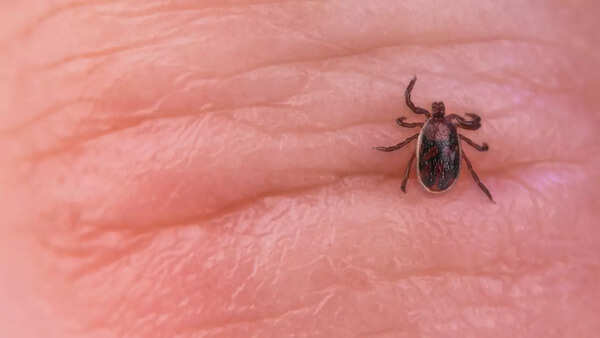Maria Palen, a 31-year-old chemical engineer from California, embodied the image of a fitness enthusiast. With a dedicated plant-based diet and consistent exercise routine, she amassed over 20,000 Instagram followers, documenting her inspiring transformation journey. However, her story took an unexpected turn when she was diagnosed with babesiosis, a parasitic infection transmitted through tick bites, leading to paralysis from the waist down by late 2024.
This health crisis underscores a crucial message: outward appearances of health do not always reflect internal realities. Palen's experience serves as a stark reminder of the hidden dangers of tick-borne illnesses, particularly for individuals who frequently engage in outdoor activities.
Initially, Palen experienced mild symptoms such as inflammation, joint discomfort, and persistent thumb pain. She initially attempted to manage these issues through dietary adjustments and increased exercise. However, her condition progressively worsened, leading to debilitating consequences.
By March 2024, she was largely confined to her bed, struggling with everyday tasks.
Eventually, a functional medicine specialist identified babesiosis, a less prevalent tick-borne disease caused by Babesia parasites that infect red blood cells. Unlike Lyme disease, babesiosis often remains undetected due to its symptoms mimicking common ailments like the flu or general fatigue. The Centers for Disease Control and Prevention (CDC) reports a doubling of babesiosis cases in the past decade, rising from 1,000 in 2011 to approximately 2,500 annually.

A tick, the culprit behind many hidden illnesses.
Palen suspects the tick bite occurred years prior during an outdoor hike, going unnoticed at the time. The infection gradually progressed, eventually impacting her nervous system. By October 2024, extreme tailbone pain prevented her from sitting, and paralysis soon followed.
Tick bites often go unnoticed due to their small size and painless nature. The extended dormancy period of some infections is even more concerning. Palen's case highlights the limited awareness surrounding less common tick-borne diseases like babesiosis.
Ticks are most active during warmer months, thriving in grassy and wooded environments. The 2024 tick season in the US was particularly severe due to milder winters, resulting in increased survival rates for tick-hosting animals. Researchers at the University of California, Riverside, warn that this surge in tick populations elevates the risk of less common infections spreading undetected.
The microbes responsible for babesiosis (Babesia microti and B. duncani) are difficult to detect because they reside within red blood cells. Recent genomic research on B. duncani reveals behavioral similarities to the malaria parasite, explaining symptoms such as fever, chills, and muscle aches that precede more severe complications.
Palen's story underscores the importance of early detection in managing tick-borne illnesses. While doctors often test for Lyme disease, babesiosis may not be immediately considered. Given the potential for co-infection with Lyme disease, symptoms can be misattributed. Healthcare providers should adopt a broader diagnostic approach, and individuals should closely monitor any unexplained changes in energy levels, muscle strength, or chronic pain, particularly after spending time outdoors.
The risk extends beyond hiking and camping. Even gardening in overgrown backyards or walking through wooded areas can expose individuals to ticks, especially without protective clothing or tick repellents.
While common advice includes wearing long sleeves and checking for ticks, Palen's experience necessitates a more comprehensive approach:
Disclaimer: This article is for informational purposes only and does not substitute professional medical advice. Consult a licensed healthcare provider for any health concerns.
Newer articles
Older articles
 Hetmyer's Heroics: Orcas Stun MI New York with Last-Ball Six in Record-Breaking MLC Chase
Hetmyer's Heroics: Orcas Stun MI New York with Last-Ball Six in Record-Breaking MLC Chase
 Android Users Face Critical Security Risks: Update Your Devices Now, Warns Government Agency
Android Users Face Critical Security Risks: Update Your Devices Now, Warns Government Agency
 Greg Chappell Hails Rishabh Pant's "Revolutionary" Batting, Likens Him to Gilchrist
Greg Chappell Hails Rishabh Pant's "Revolutionary" Batting, Likens Him to Gilchrist
 Dog-Sized Dinosaur Fossil Unearths New Insights into Prehistoric Life Alongside Giants
Dog-Sized Dinosaur Fossil Unearths New Insights into Prehistoric Life Alongside Giants
 West Indies Captain Chase Slams Umpiring After Test Loss, Demands Accountability
West Indies Captain Chase Slams Umpiring After Test Loss, Demands Accountability
 IRCTC's AI Chatbot, AskDisha 2.0, Streamlines Train Ticket Booking, Refunds & Information
IRCTC's AI Chatbot, AskDisha 2.0, Streamlines Train Ticket Booking, Refunds & Information
 Freestyle Chess India Event Scrapped Due to Sponsorship Issues; Carlsen Absence Confirmed
Freestyle Chess India Event Scrapped Due to Sponsorship Issues; Carlsen Absence Confirmed
 Moto G54 Gets Significant Price Drop in India: Check Out the New Affordable Price Tag
Moto G54 Gets Significant Price Drop in India: Check Out the New Affordable Price Tag
 New Zealand Cricket Announces Packed 2025-26 Home Schedule Featuring Australia, England, West Indies & South Africa
New Zealand Cricket Announces Packed 2025-26 Home Schedule Featuring Australia, England, West Indies & South Africa
 Converting JPG to PDF: A Comprehensive Guide for Preserving Image Quality and Ensuring Accessibility
Converting JPG to PDF: A Comprehensive Guide for Preserving Image Quality and Ensuring Accessibility